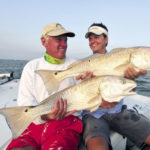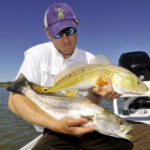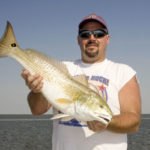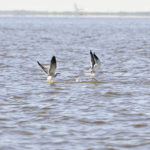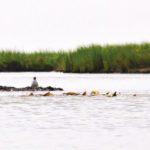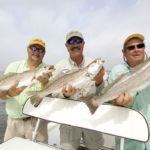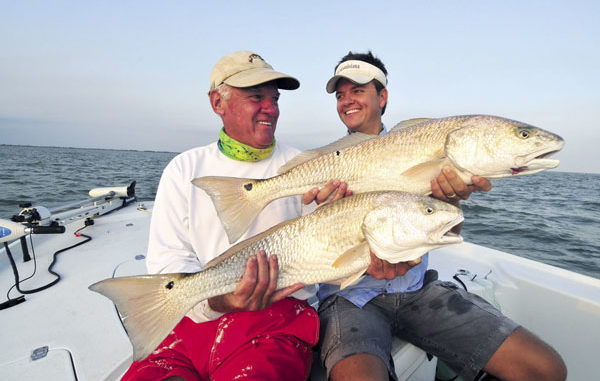
Do you enjoy working for your meals? Neither do trophy speckled trout. Use that to your advantage this month to put real wall-hangers in the boat.
If husbands could achieve trophy status by the number of their weight on the scales rather than the number of dimples on their chins, I would grade out much higher today than I did 14 years ago when my wife and I got married.
Happy heavy, love load, marriage mass — whatever you want to call it — husbands amass it around their waists with each year of marriage, especially if you married a gal that can cook better than Iron Chef Cat Cora.
Some would claim that married men get heavy because they don’t see the use in keeping trim anymore because they are no longer searching for soul mates.
Others would say that married men get heavy because they sit around on the sofa watching football all day long on Saturdays and Sundays.
I would contend that married men get heavy because we follow our wives around with a fork and knife in our hands waiting on them to feed us.
Lake Calcasieu angler Will Drost believes trophy trout are the same way, especially at his home water. However, rather than following their mating partners around waiting to get fed, they follow giant schools of redfish to lazily eat on the leftovers.
It’s easy pickings, and heavy trout seem to know they can get a meal without expending very much energy at all. The result is the same as a husband who eats a lot without ever exercising — he gets fat.
“Redfish are bottom feeders,” Drost said. “The shape of their mouths, the way they feed with their heads down and their tails up and the way they bulldoze through an area picking up whatever they can — they go through and just terrorize an area, leaving a lot of stunned, startled and shocked bait behind.”
Drost calls them big, red vacuum cleaners. Only, Oreck doesn’t make these models, so they leave a lot of stuff behind. What’s left is what compels trophy trout to follow after the giant redfish schools.
If you’re after a quick limit of 15 speckled trout during June, Horst says to stay away from the redfish schools. However, if you don’t mind fishing through 30, 40 or even 50 redfish just to catch one giant trout, this is your kind of fishing.
“My dad and I fished the CCA Trout Shoot-out here at Calcasieu a few years ago,” Drost recalled. “He won with a 7-pound trout, and I got second with a smaller 7-pound trout. Those were the only two trout we caught all day long, but we must have hooked and released 70 redfish that day. We had to fish through 70 reds to catch two 7-pound trout.”
There’s no doubt that fishing redfish to catch trout is a unique way of fishing, but it’s one that Drost has defined more and more over the last few years, and he has learned that its rewards far outweigh any difficulties associated with this style of fishing.
Through his experiences fishing redfish for big trout, Drost has discovered that the trout tend to follow on the backside of the redfish schools. That makes a lot of sense considering this would be the side of the school that would have the most dazed and confused bait.
“It seems to me that the trophy trout are always stragglers behind the reds,” Drost said. “They’re not right up in there rubbing shoulders with the redfish. Rather, they hang out behind picking up whatever bait just made the biggest mistake.”
The most important aspect of fishing redfish to catch big trout is finding big schools of redfish. In fact, other than waiting out the trout, Drost says this is the hardest part of fishing this way.
That’s why June is such a great month for this kind of fishing.
Drost says some of the largest redfish schools form during June, and they can be found anywhere from the middle of the lake to leeward shorelines in places like West Cove and the East Bank.
However, since redfish could be just about anywhere, he cautions that there aren’t any certain places that he can point to and say, “fish there” or “fish here.”
“On calm days, you can find the schools right out in the middle,” Drost said. “I like to look for slicks, but on the greasy, calm days we get during the summer, it’s hard to spot the slicks. I like to use binoculars to search for any sign of feeding reds. It could be just a little nervous-looking water, or it could be sprays of white water from feeding activity.”
However, Drost emphasized the importance of birds when looking for big schools of redfish. Schools of feeding redfish typically attract more diving birds than smaller schools of trout, so Drost checks groups of distant birds with his binoculars before deciding to go check out what’s going on.
If he determines the birds to be working over a redfish school, Drost eases into position because he doesn’t want to disturb the feeding action. He visualizes where the tail end of the school may be, and he sets up in a location where he can keep up with the fast-moving reds and make long cast toward their tails.
But you can bet Drost isn’t throwing soft-plastic Sand Eels, shrimp or Cocahoes rigged on lead heads to the rear of the redfish school. Rather, he believes that big trout are looking for big meals. That means he only throws fish-imitating lures when he’s after the fat boys.
“I’m talking heavy-duty stuff,” Drost said. “I want something that can withstand the crushing attacks of 30 redfish without getting destroyed. If I were using soft plastics, I would spend all my time changing baits. This is the territory for big topwaters, broken-back Red Fins or Catch 2000s with upsized hooks. It’s hard for a big trout to pass up a big injured mullet-style lure.”
In an effort to improve his catch ratio, Drost replaces all his treble hooks with 4/0 Mustad R 94140 BLN hooks. He rigs the front hook facing forward and the remaining hooks facing rearward. The welded-in ring keeps the hooks from spinning, and these make releasing big trout easier because they don’t do as much damage as treble hooks.
Drost also harped on the ability to distinguish between a big redfish and a big trout in the first few moments of a battle. Although it’s difficult to tell the difference between the two on their first runs, he has determined that the second run is distinctly different.
“With a big trout, there’s no way to tell the difference between it and a big redfish right at the bite,” Drost said. “They both make long initial runs, but a big trout typically won’t make a second long run. The second run will be shorter and the trout will come up to the surface, do a quick head shake and create a little white water.”
If Drost determines he’s battling a big trout instead of a redfish, he’ll back off his drag to allow the fish to peel some line and play the fish more carefully than if it were a big redfish.
“I may lose the school of redfish a while,” he said, “but it’s more important to me to get the big trout in rather than stay on the reds. I can find them again later. It’s really helpful to have a partner fishing with you when you’re doing this because if you do hook a big red, he can stay with the school while you battle the red and get him back in the water.”
Other than locating a big school of redfish, Drost says the next hardest part about fishing this way is making sure he’s on the right school of fish. Some schools may not have trout with them, and the hardest decision to make is whether to leave one school to go look for another.
“Sometimes you’ve got to give up on a school even though you’re catching a lot of redfish,” he said. “There aren’t any strict rules about how long to stay with a school. It’s more of a feeling that tells you you’re on the wrong reds.”
This is especially difficult considering that you’re only after one or two trout bites. Catching 30 or 40 reds without getting any trout bites at all can make you get fidgety to go look for another school. But you also worry about leaving one cast too soon.
You may have to make a lot of casts to a lot of schools to hook a big trout, but you can bet that if the fat boys are there, they aren’t going to pass up anything that looks like an injured mullet for too long.
Think about it like this: If your wife tossed a live, flopping fish on one side of your dinner table and a golden-brown fried fillet on the other, which one would you grab?
Me? I’m grabbing the fillet because I’m lazy and want to expend as little energy as possible to obtain my meals.
It might add some bounce above my belt, but that would just put me one step closer to trophy status.
